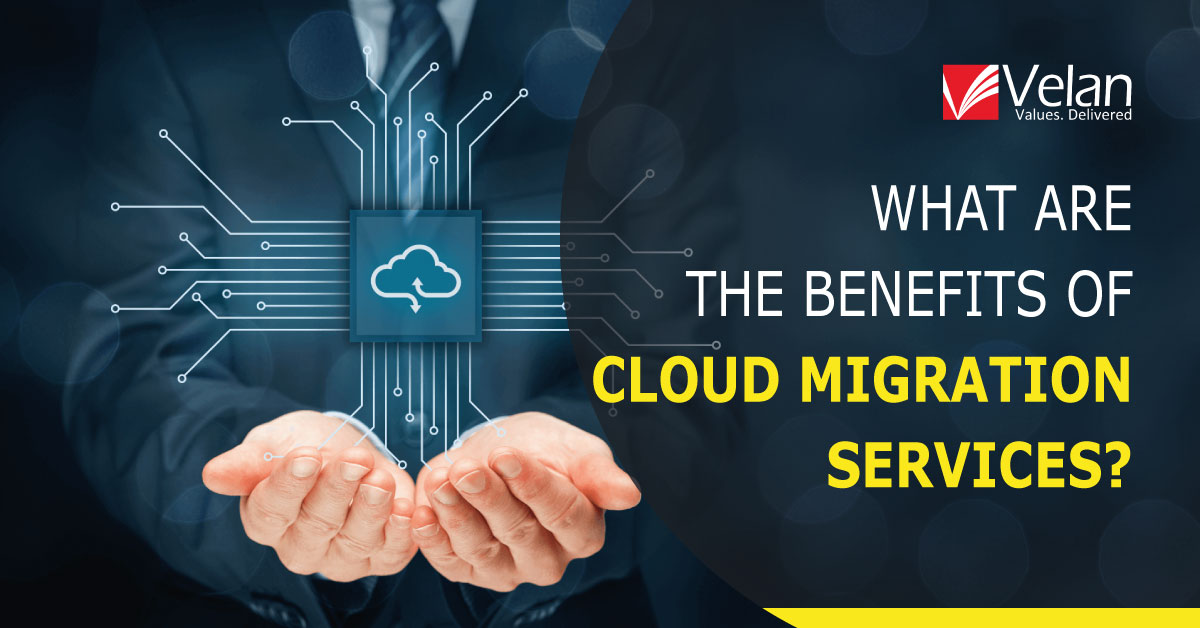Cloud Migration 101: What? Why? And How? 6 May 2021

Surprisingly and not so surprisingly, the demand for the cloud skyrocketed in 2020 compared to 2019, even during the irrational economic decline. The most obvious reason: increased demand created by the pandemic – COVID-19, lockdowns, and work from home. The growth in the cloud continued to expand compared to other industry sectors.
A lot of companies are moving their services and applications to the cloud on a daily basis, despite its challenges. Let us begin with the basics in this blog and its successors – what is cloud – what is cloud migration and what businesses stand to gain – strategies – a checklist developed by Velan for making the migration with confidence – the advantages and disadvantages of various types of the cloud.
| Cloud helps you concentrate on building your services and apps; because the infrastructure will be taken care of.
– says the cloud technology.
The Cloud computing market is massive and has a huge scope for further expansion. The Synergy Research Group has calculated a 24% growth over the previous year (2018), after meticulous consideration of seven key cloud service and infrastructure market segments, operators, and vendors. The revenue indicates an excess of $150 billion during the first half of 2019.
Let’s get into understanding the million-dollar concept.
What is the cloud?
The cloud is the Internet!
It refers to the applications, services, and data that run on the internet, instead of on your desktop’s hard drive. It is a virtual server that gives you access to your data anytime, anywhere, and on any device.
Cloud servers are placed in data centers worldwide. It eliminates the need to have physical servers and local storage spaces. Most cloud services can be accessed via web browsers like Google Chrome, Safari. A few companies offer exclusive mobile apps.
Cloud enables the users to log in to their social media accounts on any device with all their data – photos, chats, posts, videos. e-Commerce accounts like Amazon, Flipkart; email service providers like Gmail, Yahoo Mail, Apple Mail, Microsoft Office 365; cloud storage providers like iCloud, Dropbox, Google Drive; streaming services like Netflix, Amazon Prime, Hotstar all operate the same way. You need not fear maxing out your smartphone’s or laptop’s internal storage.
The success of cloud technology is the easy access it provides to your data just with an Internet connection. It is exactly what allows a team to collaborate and make edits on Google docs simultaneously. It encourages real-time.
For businesses, adopting cloud computing eradicates overheads and IT costs. The cloud vendors will provide the infrastructure, handle the remote servers, update and maintain them; manage computing, storage. It makes a huge impact on the small companies who may not be able to afford cloud luxury. It makes worldwide operations seamless.
A difference between the internet’s client-server model and the cloud…
Internet is a connection between clients, servers, and infrastructure. Clients request the server, and the server responds to it by sending what they ask for.
In cloud computing, the cloud servers extend beyond responding to the server’s requests, the cloud runs the programs, manages and stores data.
Cloud Computing working model
Virtualization is what makes cloud computing feasible. It enables simulated, digital-only ‘virtual’ computers known as virtual machines. It behaves similarly to physical computers. It sandboxes the virtual machines; meaning virtual machines will be operating on the same host with zero communication between the machines, files, and applications whatsoever.
Virtual machines are very efficient on hardware hosting them. Multiple companies’ information can be operated simultaneously by running many virtual machines simultaneously. One server becomes many, one data center becomes a myriad hosting multiple information of the organization at once. Hence, the cloud service providers can successfully use their cloud servers to attend to many customers at a low cost.
Cloud servers need a stable internet connection always, so even if individual servers go down, the company’s operations will not be affected as the cloud vendors back up the data on multiple machines worldwide.
Cloud services can be accessed using an app or a browser through the internet, regardless of the device.
Cloud service models
The cloud service models define how the services are offered via the cloud.
● SaaS: Software as a Service
Software as a Service, or SaaS, is software applications available over the internet. SaaS applications are hosted on cloud servers. It just works without any need for installing things on the computer, smartphones, tabs. The updates and security patches run on their own.
Examples: G Suite apps, Microsoft 365, Dropbox, Slack, Facebook, Gmail, Youtube.
● PaaS: Platform as a Service
Platform as a Service, or a PaaS, offers a foundation for the developers to create, test, deploy, and scale their applications. Development tools, operating systems, infrastructure, database management, storage will be offered by the PaaS vendors. The companies need not pay for the hosted applications, but they must pay for the stuff needed to build their apps. It is similar to BYO data and applications.
Examples: Microsoft Azure, Google App Engine, Force.com, Heroku.
● IaaS: Infrastructure as a Service
Infrastructure as a Service, or an IaaS, refers to renting a server in the cloud. It means the company rents the storage and servers from the cloud service providers. The company can use the infrastructure to create its applications. The cloud service provider will be the owner of the hardware, responsible for its maintenance, while you can use it for your business.
Example: Amazon Web Services (AWS), Microsoft Azure, Google Compute Engine.
Earlier, there were only three cloud service models of cloud computing, but in recent years, we have a fourth model – Function as a Service (Faas).
● Function-as-a-Service (FaaS):
Function as a Service, or a FaaS, is famously known as serverless computing. It breaks the cloud applications into smaller parts that run when there is a demand for them. FaaS also runs on servers, but they do not run on dedicated machines.
Cloud deployment types
The cloud deployment types refer to the location and management of the cloud servers.
● Private cloud
A private cloud is a server located in the data center that is exclusive to one organization. Companies that need customization and complete control over their data can opt for private clouds.
The private cloud providers are Oracle, Dell, IBM, Hewlett Packard Enterprise (HPE).
● Public cloud
With a public cloud, the cloud service provider controls and runs the services over the internet. The services can be availed on a pay-as-you-use model or for free to users. It is the most common cloud deployment model as it is available 24/7, scalable, efficient, and has a simple infrastructure. On the flip side, it may be vulnerable because multiple users can share spaces on the same server.
The public cloud providers are IBM Cloud, Amazon Web Services (AWS), Google Cloud Platform (GCP), Microsoft Azure.
● Hybrid cloud
A hybrid cloud is a combination of public and private clouds. It allows users to juggle between the two models – a business can use a private cloud for a few services and a public cloud for others and may use a public cloud as a backup.
● Multicloud
One of the most common cloud deployment models amongst enterprises, multicloud is the use of multiple cloud servers in a single environment. The users can combine private and public models, or use multiple public models to lessen their dependence on a single cloud service provider.
Multicloud and hybrid cloud deployment models are different. The former indicates using multiple services from Azure and AWS, while the latter means using multiple cloud deployment models like private and public, or public and public.
Should you consider cloud migration for your business?
Yes. And here are the reasons why I say that.
- Lesser Cost: Migrating to the cloud will reduce your capital as there is no need to maintain hardware and its related expenses. Besides, the cloud allows you to pay as you use the cloud services and save money during zero usage.
- Improved security: Cloud provides improved security against hacking, security breaches, and data theft. Unlike physical servers that need constant security management, cloud service providers will monitor your data 24/7 and protect it from any breaches. Regular audits will be performed by your vendors.
- Versatility and Optimization: With the cloud, you can scale your operations, remote server capacity based on your company’s bandwidth demands.
- Easy Collaboration: Team members and colleagues can simultaneously connect effortlessly and work on the same documents. It improves employee engagement.
- Faster Disaster Recovery: A virtual, cloud-based server is not dependent on hardware. During a disaster, your data, security patches, apps, services, and programs will be safe and can be retrieved within minutes without the loss of any functionalities.
- Excellent Customer Reach: Cloud migration helps your business connect with more customers worldwide. Your customers can integrate their apps on various devices anytime.
- Faster Time-to-Market: Whether you are launching a product or releasing an update, the cloud leads to faster time-to-market. It makes your business gain a competitive advantage and more customers.
Of course, there are challenges to cloud migration like interoperability, resource availability and management, and compromising data integrity. Every new adoption comes with a certain degree of risk, however, with proper planning and an informed team, you can outrun the risks with a host of benefits.
How to build a cloud migration plan that’s perfect for your business?
The cloud migration strategy: Cloud migration may sound like a direct, straightforward approach where you simply switch from a physical server to a virtual infrastructure. However, in reality, cloud migration is not a completely direct, straightforward approach as it elicits continuous reinvention if the cloud is to reduce costs or create new market opportunities. There is no one-size-fits-all approach. It needs a bespoke strategy based on the nature of your business, the size of your organization, the services offered, and the reasons you are adopting the cloud.
A single application could be associated with various business processes, impacting vendors, regulatory compliances, balance sheets, and multiple stakeholders could have unique motives and expectations from the cloud migration. A simple process could often result in a mist of inconsistent goals, cost surges, and uneven dependencies. While a few organizations may venture into the cloud for lowering their capital expenses, others may want to adopt the cloud to free their resources and have them work on different tasks. Hence, the cloud migration plan must be shaped based on the unique aspects of your business.
Prepare your cloud migration by outlining your company goals. Your reasons to adopt the cloud must answer the questions below:
- Why do you need to migrate to the cloud?
- What do you want to accomplish after migrating to the cloud?
- What criteria will you use to measure the success of cloud migration?
The three questions mentioned above will help you plan a strategy that will be tailored for your business. Get the answers to these questions for every stakeholder. The different answers will help you in making informed decisions.
When you have answers, you can now approach a cloud solution provider like Velan to achieve better performance, tighter security, address the missing gaps, increase efficiency, and reduce the overall cloud migration costs.
Alternatively, at Velan, our cloud experts will give you a questionnaire, designed after completely understanding your business, to fill so we could devise a bespoke cloud strategy for you. It will save you time, bar you from any confusion, and give you a clear overview of your requirements and your path ahead. We understand that it is highly critical to “disrupt the market without obstructing the business” during the migration.





